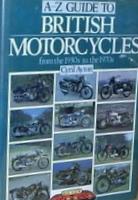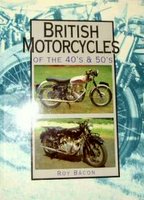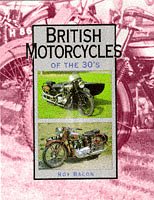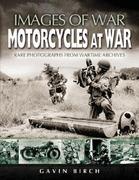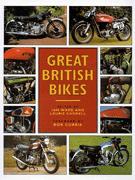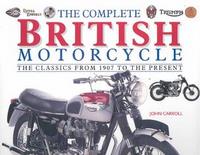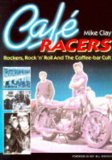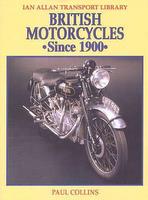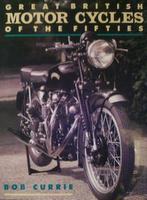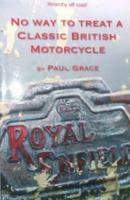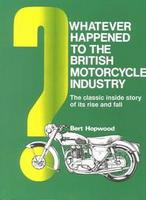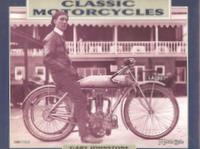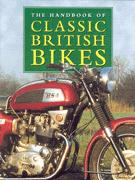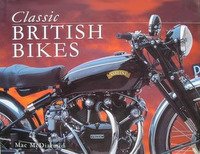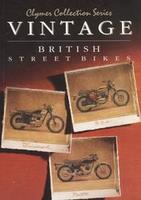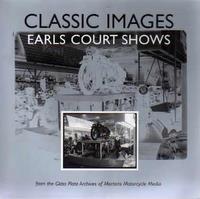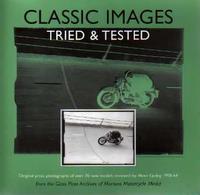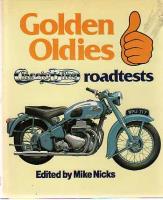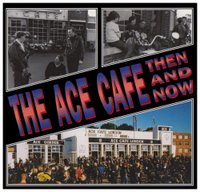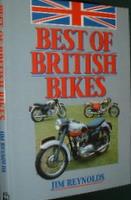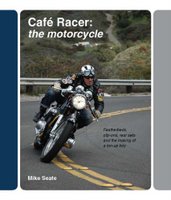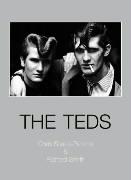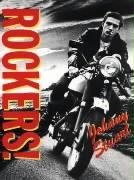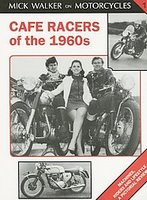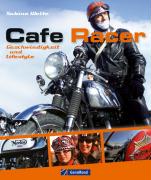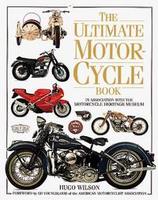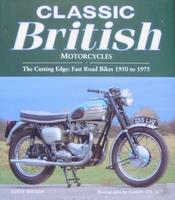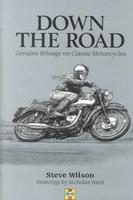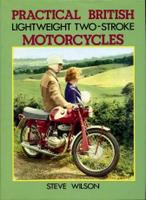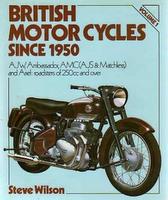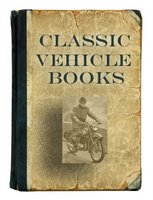Classic British Bike Books
Classic Vehicle Bookshelf >> Classic Motorcycle Books >> Classic British Bike Books
This selection of general classic British bike books, covers the history and development of the British motorcycle industry, British makes and models.
CYRIL AYTON
A-Z Guide To British Motorcycles From The 1930s To The 1970s by Cyril Ayton (1991). A well-researched alphabetical coverage of the majority of British motorcycle manufacturers, and most of their models, from the 1930s to the 1970s. A valuable reference source.
JACK BACON
Lost Motorcycles Of The 1920s by Jack Bacon (2008). The 1920s were an amazing decade in motorcycle development. "Lost Motorcycles of the 1920s" describes, in as much detail as possible, over 50 of these lesser known motorcycles, providing a wealth of information on makes from Abbotsford and Alwin to Turner, Weaver and the Xtra Car - not forgetting the many transient, but somewhat better known marques such as Blackburne, Radco and Raleigh for example. Each model and make is described in detail and accompanied by as many illustrations as possible. "Lost Motorcycles" also offers some fascinating and helpful insights into the many facets of motorcycling during the 1920s - the roads and garages, suspension, tyres and clothing, for example - all of which helps set these motorcycles in their period and gives a real feel for what motorcycling must have been like some 80 years ago. This title is absolutely invaluable to restorers and historians of early British motorcycles.
ROY BACON
British Motorcycles Of The 1940s And 1950s by Roy Bacon (1989) is a comprehensive guide to 79 of the well-known and obscure post-war British marques from Aberdale to Zenith.
British Motorcycles Of The 1930s: The A-Z Of Pre-war Marques From AER Through To Zenith by Roy Bacon (1986) recalls a decade when the industry had to rise from the depression, struggle to survive hard times, and then answer the call to arms. This they did well enough for many machines to serve their country and later help a postwar world to ride to work.
British Motorcycles Of The 60s: Detailed History Of 50 Marques from AJS To Wasp by Roy Bacon (1988)
GAVIN BIRCH
Motorcycles at War: Images Of War, Rare Photographs From Wartime Archives by Gavin Birch (2006). The author, who is the Photo Archivist at the IWM has unearthed images of all the major marques. Famous British names (Triumph, Norton, Matchless, BSA, Velocette, James and Rudge) feature along with the bigger American machines from Indian and Harley-Davidson. German bikes have their own chapter with classics such as NSU, Zundapp and BMW and include hybrid tracked motorcycles known as Kettengrad - with some shots actually taken by General Erwin Rommel himself. Also covered are rare experimental prototypes photographed during trials and later in combat, the 'funnies' of the wartime biking world such as the Airborne forces Excelsior Welbike (British) and the Cushman parascooter (US).Together this is a unique collection of two-wheeled images.
ROLAND BROWN
Classic Motorcycles: The Complete Book Of Motorcycles And Their Riders by Roland Brown (1999) is divided into two sections, 'The World of Motorcycling', a history of the motorcycle, including special features on sport and racing, touring, custom motorcycles, record breaking through the years, motorcycles at war, in the movies, at work, and more. The A-Z of Motorcycles: A marque-by-marque guide with illustrations of every motorcycle augmented by authoritative and comprehensive text.
LAURIE CADDELL & IAN WARD
Great British Bikes by Laurie Caddell & Ian Ward (1989). From the Excelsior of 1896 to the last bikes from Triumph in 1983 this book is a celebration of the glorious British motorbike.
JOHN CARROLL
The Complete British Motorcycle: The Classics From 1907 To The Present by John Carroll (2001)
MIKE CLAY
Cafe Racers: Rockers, Rock 'N' Roll And The Coffee-Bar Cult by Mike Clay (1998). This one-of-a-kind history recalls the bygone era of cafe racers -- those motorcycles which earned an esteemed place among the mod coffee bar set of the 1950s and '60s. More than 250 black-and-white photographs have been gleaned from movie stills, newspapers, and private collections to tell the story of the bikes, the drivers, and what cafe racing was all about.
PAUL COLLINS
British Motorcycles Since 1900 by Paul Collins (1998). For biking enthusiasts worldwide the names of the great British manufacturers trip off the tongue - BSA, Triumph, Norton, Rudge, Ariel, Greeves, Velocette, Vincent and many more; names that are redolent of the era when British bikes dominated motor sport. Such was the impact of the postwar Japanese competition, however, that the British motorcycle industry all but died. There have been occasional green shoots of recovery, but these were often ill-funded and doomed to eventual failure. But, like many other industries in Britain, rumours of the final death of the industry have been greatly exaggerated and, as we approach the centenary of the motor industry, there are grounds for optimism that from the ashes of earlier failures a new motorcycle industry is emerging. Paul Collins examines the history of each of the various manufacturers that gave Britain its pre-eminence. The book is illustrated thoughout with a superb selection of photographs that recall the glory years.
BOB CURRIE
Classic British Motorcycles by Bob Currie (1993) is a collection of twenty-five motorcycles from 1947-1975. Includes AJS, BSA, DMW, Douglas, Francis-Barnett, Excelsoir, Greeves, Matchless, Norton, Panther, Royal Enfield, Sunbeam, Triumph, Velocette, and Vincent motorcycles.
Classic British Motorcycles Over 500cc From The National Motorcycle Museum by Bob Currie (1988). In this second volume describing and illustrating a further selection of classic machines from the National Motorcycle Museum at Bickenhill near Birmingham, the author turns his attention to the 'big stuff' of over 500cc. These heavyweights not only include the high-powered 'glamour' machines but also the pre-war sidecar hauling workhorses. The stories of more than 40 examples are told here, each illustrated in colour and accompanied by full technical specifications.
Classic Motorcycles The Final Years by Bob Currie (1984). In this book twenty-five bikes have been selected from the National Motorcycle Museum to show the diversity of the machines built in an era when the British industry was at its peak and supplied 90% of the world demand.The profile of each bike is illustrated with a large colour portrait and several black and white photographs. Among the bikes featured are the Panther 120S, the BSA Gold Star, the Manx Norton, the Greeves ISDT Special and the Triumph Trophy.
Great British Motorcycles Of The Sixties by Bob Currie (2000). Each of the bikes shown are given a full write up with an end section on each of the bikes giving specifications. This book shows a cross-section when the British Industry was slipping towards near extinction. The road tests are as they were originally published in the journal Motor Cycle. Contains drawings and photographs of variants.
Great British Motorcycles Of The Fifties by Bob Currie (1990)
PAUL GRACE
No Way To Treat A Classic British Motorcycle by Paul Grace (2006). If you have a big pile of bits which could possibly be built into an Enfield off-roader, and no experience of riding in classic scrambles whatsoever, then it seems only natural to take on a classic motocross challenge.
BERT HOPWOOD
Whatever Happened To The British Motorcycle Industry?: The Classic Inside Story Of Its Rise And Fall by Bert Hopwood (1981). In depth look at our once great motorcycle Industry from its inception and through until the time that the foreign bikes took over our once dominant market, with cheaper high reving machines that often sounded and sometimes looked like 'toys' when compared to our Traditional British 'Thumpers'. Thankfully, although nearly reaching extinction, it seems that some British Bike production has been saved, albeit it small numbers to a descerning clientele. This then is the story of how this all came about in text, illustration and picture.
PETER HOWDLE
Best Of British: Classic Bikes Of Yesteryear by Peter Howdle (1979) breathes life into 38 classic products of the national industry from utility workhorses to snorting roadburners that still live on in modern legend. Norton, Triumph, BSA, Vincent, Ariel, Scott, Panther, Matchless, AJS, Velocette and their many companions were the pride of Britain.
GARY JOHNSTONE
Classic Motorcycles by Gary Johnstone (1993) celebrates the cult and the culture of motorcycling. Rather than an exhaustive anthology of machines, it is a winding journey through the twentieth century, seeking out the essential factors which shaped the unique design of the true 'classics' of the motorcycle world and which defined the motorcycle 'heritage' of each country.
JOE KELLY
The Handbook Of Classic British Bikes by Joe Kelly (2001) covers the first century of the British motorcycle industry, from its beginnings to the present day.
ANDREW KEMP & MIRCO DE CET
The Handbook Of Classic British Bikes by Andrew Kemp & Mirco De Cet (1999) covers the 1st century of the British motorcycle to present. Profiles 100 motorcycles with full colour photos and text.
MAC McDIARMID
Classic British Bikes by Mac McDiarmid (1997) records the most momentous events and machinery of much of the first six decades of this century.
JUDITH & MARTIN MILLER
Miller's Classic Motorcycles Price Guides by Judith & Martin Miller. Professional handbooks from many years, that provide pictures and prices of many vintage motorcycles, scooters, and sidecars, as well as some vintage motorcycle memorabilia.
ROBERT MILLS
Vintage British Street Bikes by Robert Mills (No Date)
MORTONS MOTORCYCLE MEDIA
Classic Images: The Earls Court Shows by Mortons Motorcycle Media (2001). From the Glass Plate Archives of Mortons Motorcycle Media. From the Shows of 1949 - 1960. Therefore principally British Bikes, Sidecars and ThreeWheelers as presented to the eager British Public seeing much of what was on offer for the very first time. Needless to say the B/W photos are of the highest quality, reflecting much detail essential in the fine restoration these old warriors deserve.
Classic Images: Tried & Tested by Mortons Motorcycle Media (2002). Original press photographs of over 70 new models reviewed by Motor Cycling 1958-64 from the Glass Plate archives of Mortons Motorcycle Media.
MIKE NICKS
Golden Oldies: Classic Bike Road Tests by Mike Nicks (1981). Vintage motorcycles are tested and then described by the rider, complete with specifications of such great makes as Triumph, Norton, Royal Enfield and BSA.
WINSTON RAMSEY
The Ace Cafe Then And Now by Winston Ramsey (2002). During the 1960s swarms of motorcyclists roamed along London's North Circular Road in nightly burn ups. Their pit stop was the Ace Cafe at Stonebridge Park. This is their story as told by the boys who raced and the policemen who chased, woven against a background of contemporary reports.
JIM REYNOLDS
Best Of British Bikes by Jim Reynolds (1990) is a close-up of some of the outstanding machines produced by the British motorcycle industry from the end of the Second World War. Model histories, the pleasures and problems experienced by those who have lovingly restored them for competition or ride-to-work use, specifications, a host of archive and present-day photographs, details of owners' clubs and sources of spare parts.
MIKE SEATE
Cafe Racer: The Motorcycle: Featherbeds, Clipons, Rear-Sets And The Making Of A Ton-Up Boy by Mike Seate (2008) is a fascinating expose of the culture of the cafe racer - a motorcycle culture which emerged from WWII in the UK and the USA. Today, it's in the midst of a huge restrospective.
CHRIS STEELE-PERKINS
The Teds by Chris Steele-Perkins (2002). The Teddy Boys were a flashily dressed, rebellious and sometimes violent youth movement that originated in Britain in the '50s. The three-quarter-length Edwardian jacket with velvet collar, drainpipe trousers and quiff became a focus of male fashion which still holds cult status today. "The Teds" combines image and text to tell their story -- a fascinating tale spanning three decades.
JOHNNY STUART
Rockers! Kings Of The Road by Johnny Stuart (2009). The mean and moody leather boy on a thundering bike is one of the strongest, most potent images of popular culture. Rejecting stereotyped bourgeois conformism, rockers crystallised a youth style. This book is about that epic style, evolving from a cross-fertilisation of influences, a love affair with bikes and speed, and a British interpretation of American 'glamour'. All this took on a new perspective with the eruption of rock'n'roll. Streamlined drainpipe jeans and clean-cut leathers were tailored for the sleek, throbbing British 'iron' and the gutsy music. All were elements of the style, reflecting a raw edginess, a search for excitement, a hint of sex and even of violence. This style survived Mods and flower power, not even eclipsing before today's long-haired 'bikers'. To explain the myth and magic, the author looks at dream machines, the original heroes and, above all, the ton-up boys themselves. Why the cult endures is encapsulated in the photographs. Rare and eye-catching they explain the enduring fascination of rocker culture.
MICK WALKER
Cafe Racers Of The 1960s: Machines, Riders And Lifestyle by Mick Walker (1994) is a pictorial history of motorcycles - and the riders - who created the cafe racer craze. The author looks at the BSA Gold Star, the Triumph/Norton hybrid and others and recalls the leather-jacketed "rockers" who indulged in burn-ups on Britain's roads, and gained nationwide notoriety through their seafront battles with the archrivals, the "Mods". He explains the origins of the movement, profiles its machinery and its personalities, and describes the equipment, livery and lifestyle of the cafe racer cult. A nostalgic gallery of contemporary photographs recreates a vivid portrait of the period.
SABINE WELTE
Cafe Racer by Sabine Welte (2009)
HUGO WILSON
The Ultimate Motorcycle Book by Hugo Wilson (1993) is colourful, loaded with photos of over 200 bikes, it's informative, and, most importantly, it's a blast. Along with historical tidbits about the earliest cycles during the 1890s and the use of bikes during both world wars, Wilson provides sections devoted to racing, touring, motocross, and customizing. US Bikes, headed by the estimable Harley-Davidson, are featured first, but classic British models such as Triumph and Vincent are spotlighted alongside Italian, French, and Scandinavian bikes, German military models, bikes from companies such as BMW and Hunch, and, of course, the Japanese giants: Honda, Kawasaki, Suzuki, and Yamaha. Full-color photographs virtually leap off the page, and their captions point out pertinent facts (a snapshot of a vivid red 1988 Electra Glide is highlighted by the bike's disc brakes and its separate gearbox). To top it all off, neophyte gearheads will swoon over the intricate graphics provided in a section that explains just how a motorcycle operates. For veteran bike enthusiasts as well as folks who've just recently discovered that they're "born to be wild."
STEVE WILSON
Classic British Motorcycles: The Cutting Edge: Fast Road Bikes 1950 To 1975 by Steve Wilson (1998)
Down The Road: Genuine Mileage on Classic Motorcycles by Steve Wilson (2000). A hand's-on story of everyday life with a twin-cylinder British Triumph Tiger and BSA Gold Star, both in UK and further afield. The anecdotes, articles and general comments will relate well to our readers who have found themselves in similar plight.
Practical British Lightweight Two-Stroke Motorcycles by Steve Wilson (1990). For those who already have a two-stroke or have a special interest in the British lightweight versions, this is a practical guide to obtaining, registering and servicing a machine that will appreciate in value.
British Motor Cycles Since 1950: AJW, Ambassador, AMC (AJS and Matchless) And Ariel: Roadsters Of 250cc And Over by Steve Wilson (1982). First of four volumes which is both a readable and fascinating record of a great era in British biking and also an easily accessible work of reference.
British Motor Cycles Since 1950: BSA, Cotton, Douglas, DMW, Dot, EMC, Excelsior And Francis-Barnett: Roadsters Of 250cc And Over by Steve Wilson (1983)
British Motorcycles Since 1950: Greeves, Hesketh, Indian, James, Norman and Norton: Roadsters Of 250Cc And Over by Steve Wilson (1992)
British Motor Cycles Since 1950 : Panther, Royal Enfield, Scott, Silk, Sunbeam, Sun and Tandon : Roadsters Of 250cc And Over by Steve Wilson (1991)
Classic British Motorcycle DVDs
Classic British Motorcycle Books By Manufacturer
- AJS Motorcycle Books
- AKD Motorcycle Books
- AMC Motorcycle Books
- Ariel Motorcycle Books
- Brough Superior Motorcycle Books
- BSA Motorcycle Books
- Douglas Motorcycle Books
- Excelsior Motorcycle Books
- Greeves Motorcycle Books
- Hesketh Motorcycle Books
- Humber Motorcycle Books
- James Motorcycle Books
- JAP Motorcycle Books
- Matchless Motorcycle Books
- New Imperial Motorcycle Books
- Norton Motorcycle Books
- OK-Supreme Motorcycle Books
- Panther Motorcycle Books
- Pride & Clarke (Dealers) Motorcycle Books
- Radco Motorcycle Books
- Raleigh Motorcycle Books
- Royal Enfield Motorcycle Books
- Rudge-Whitworth Motorcycle Books
- Scott Motorcycle Books
- Singer Motorcycle Books
- Sturmey-Archer Motorcycle Books (Gear Hubs)
- Sunbeam Motorcycle Books
- Triumph Motorcycle Books
- Velocette Motorcycle Books
- Vincent Motorcycle Books
Classic Motorcycle Books By Country
- Classic American Bike Books From Emblem to Yale
- Classic Australian Bike Books
- Classic Austrian Bike Books From Puch to Laurin & Klement
- Classic British Bike Books From AJS to Vincent
- Classic Czech Bike Books From CZ to Jawa
- Classic German Bike Books From Adler To Zundapp
- Classic Italian Bike Books From Aremacchi to Sertum
- Classic Japanese Bike Books From Hodaka to Yamaha
- Classic New Zealand Bike Books
- Classic Spanish Bike Books From Bultaco to Ossa
Classic Motorcycle Books
- General Classic Motorcycle Books
- Classic American Bike Books
- Classic Australian Bike Books
- Classic Austrian Bike Books
- Classic British Bike Books
- Classic Czech Bike Books
- Classic German Bike Books
- Classic Italian Bike Books
- Classic New Zealand Bike Books
- Classic Spanish Bike Books
- General Interest Motorcycle Books
